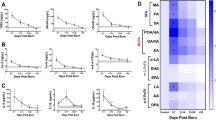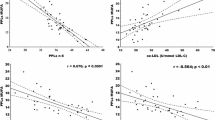Abstract
The objective of this study was to examine compositional and quantitative changes in fatty acids of plasma components and red blood cell phospholipids (PL) immediately following and during recovery from burn injury. Subjects (n=10) with >10% total body surface area burn had blood drawn at specific timepoints (0 to >50 d) following burn injury. Fatty acid composition of red blood cell PL and plasma PL, cholesteryl esters (CE), and triglycerides was determined using gas-liquid chromatography after separating each fraction from extracted lipids by thin-layer chromatography. Total plasma PL and CE in burn patients were lower than in healthy control subjects with reduced 20∶4n−6, n−6, and n−3 fatty acids and higher levels of monounsaturated and saturated fatty acids early after burn. CE levels remained half that of healthy control values up to 50 d post-burn. Red blood cell PL had decreased 20∶4n−6 content and profiles similar to that of an essential fatty acid deficiency early after burn. These results suggest an impairment in lipoprotein and polyunsaturated fatty acid metabolism in the early post-burn period. Lower levels of 20∶4n−6 and n−3 fatty acids in every plasma fraction suggest increased use of these fatty acids for wound healing and immune function following burn injury. Further work is needed to determine the ability of burn patients to utilize essential fatty acids in order to design nutritional intervention that promotes wound healing and immunological functions consistent with recovery in these patients.
Similar content being viewed by others
Abbreviations
- BSA:
-
bovine serum albumin
- CE:
-
cholesteryl ester
- MCT:
-
medium-chain triglycerides
- MUFA:
-
monounsaturated fatty acids
- PC:
-
phosphatidylcholine
- PE:
-
phosphatidylethanolamine
- PG:
-
prostaglandin
- PI:
-
phosphatidylinositol
- PL:
-
phospholipid
- PS:
-
phosphatidylserine
- PUFA:
-
polyunsaturated fatty acid
- RBC:
-
red blood cell
- SFA:
-
saturated fatty acid
- TBSA:
-
total body surface area
- TG:
-
triglyceride
References
Wolfe, R.R., Shaw, J.H., and Durkot, M.J. (1983) Energy Metabolism in Trauma and Sepsis: The Role of Fat, Prog. Clin. Biol. Res. 111, 89–109.
Gottschlich, M.M., and Alexander, J.W. (1987) Fat Kinetics and Recommended Dietary Intake in Burns, JPEN J. Parenter. Enteral Nutr. 11, 80–85.
Wolfe, R.R., Herndon, D.N., Jahoor, F., Miyoshi, H., and Wolfe, M. (1987) Effect of Severe Burn Injury on Substrate Cycling by Glucose and Fatty Acids, N. Engl. J. Med. 317, 403–408.
Barton, R.G. (1994) Nutrition Support in Critical Illness, Nutr. Clin. Pract. 9, 127–139.
Harris, R.L., Cottam, G.L., Johnston, J.M., and Baxter, C.R. (1981) The Pathogenesis of Abnormal Erythrocyte Morphology in Burns, J. Trauma 21, 13–21.
Caffrey, B.B., and Jonsson, H.T., Jr. (1981) Role of Essential Fatty Acids in Cutaneous Wound Healing in Rats, Prog. Lipid Res. 20, 641–647.
Hulsey, T.K., O'Neill, J.A., Neblett, W.R., and Meng, H.C. (1980) Experimental Wound Healing in Essential Fatty Acid Deficiency, J. Pediatr. Surg. 15, 505–508.
Calder, P.C. (1995) Fatty Acids, Dietary Lipids and Lymphocyte Functions, Biochem. Soc. Trans. 23, 302–309.
Alexander, J.W. (1986) William A. Altemeier Lecture. Nutrition and Infection. New Perspectives for an Old Problem, Arch. Surg. 121, 966–972.
Calder, P.C. (1999) Dietary Fatty Acids and the Immune System, Lipids 34 (Suppl.), S137-S140.
Fischer, M.A., and Black, H.S. (1991) Modification of Membrane Composition, Eicosanoid Metabolism, and Immunore-sponsiveness by Dietary Omega-3 and Omega-6 Fatty Acid Sources. Modulatiors of Ultraviolet-Carcinogenesis, Photochem. Photobiol. 54, 381–387.
Gottschlich, M.M. (1992) Selection of Optimal Lipid Sources in Enteral and Parenteral Nutrition, Nutr. Clin. Pract. 7, 152–165.
Kinsella, J.E., Lokesh, B., Broughton, S., and Whelan, J. (1990) Dietary Polyunsaturated Fatty Acids and Eicosanoids: Potential Effects on the Modulation of Inflammatory and Immune Cells: An Overview, Nutrition 6, 24–62.
Warden, G.D. (1973) Fluid Resuscitation and Early Management, in Total Burn Care (Herndon, D.H., ed.) pp. 53–60, WB Saunders Co., Philadeliphia.
Leape, L. (1970) Initial Changes in Burns: Tissue Changes in Burned and Unburned Skins of Rhesus Monkeys, J. Trauma 10, 488–492.
Field, C.J., Gougeon, R., and Marliss, E.B. (1991) Changes in Circulating Leukocytes and Mitogen Responses During Very-Low-Energy All-Protein Reducing Diets, Am. J. Clin. Nutr. 54, 123–129.
Field, W.E., Ferguson, F.G., Reddanna, P., and Reddy, C.C. (1988) The Effect of Selected Arachidonic Acid Metabolites on Natural Killer Cell Activity, Prostaglandins 36, 411–419.
Layne, K.S., Goh, Y.K., Jumpsen, J., Ryan, R.A., Chow, P., and Clandinin, M.T. (1996) Normal Subjects Consuming Physiological Levels of 18∶3(n−3) and 20∶5(n−3) from Flaxseed or Fish Oils Have Characteristic Differences in Plasma Lipid and Lipoprotein Fatty Acid Levels, J. Nutr. 126, 2130–2140.
Touchstone, J.C., Chen, J.C., and Beaver, K.M. (1980) Improved Separation of Phospholipids in Thin-Layer Chromatography, Lipids 15, 61–62.
James, M.J., Gibson, R.A., D'Angelo, M., Neumann, M.A., and Cleland, L.G. (1993) Simple Relationships Exist Between Dietary Linoleate and the n−6 Fatty Acids of Human Neutrophils and Plasma, Am. J. Clin. Nutr. 58, 497–500.
Batstone, G.F., Carlson, L.A., and Liljedahl, S.O. (1976) Metabolic Studies in Subjects Following Burn Injury, Burns 2, 207–211.
Birke, G., Carlson, L.A., and Liljedahl, S.O. (1965) Lipid Metabolism and Trauma. 3. Plasma Lipids and Lipoproteins in Burns, Acta Med. Scand. 178, 337–350.
Coombes, E.J., Levick, P.L., and Shakespeare, P.G. (1979) Lipid Studies After Burn Injury in Man, Burns 5, 265–268.
Kaufman, T., Brook, G.J., Hirshowitz, B., and Amir, I. (1978) Effect of an Egg-Rich Diet on Plasma Lipids and Proteins in Severely Burned Patients, Isr. J. Med. Sci. 14, 732–740.
Coombes, E.J., Shakespeare, P.G., and Batstone, G.F. (1980) Lipoprotein Changes After Burn Injury in Man, J. Trauma 20, 971–975.
Harris, R.L., Frenkel, R.A., Cottam, G.L., and Baxter, C.R. (1982) Lipid Mobilization and Metabolism After Thermal Trauma, J. Trauma 22, 194–198.
Fukushima, R., Alexander, J.W., Wu, J.Z., Mao, J.X., Szczur, K., Stephens, A.M., Ogle, J.D., and Ogle, C.K. (1994) Time Course of Production of Cytokines and Prostaglandin E2 by Macrophages Isolated After Thermal Injury and Bacterial Translocation, Circ. Shock 42 154–162.
Waymack, J.P., Guzman, R.F., Burleson, D.G., McManus, A.T., Mason, A.D., and Pruitt, B.A.J. (1989) Effect of Prostaglandin E in Multiple Experimental Models. VI. Effect on T-Cell Subsets, Prostaglandins 38, 345–353.
Grbic, J.T., Mannick, J.A., Gough, D.B., and Rodrick, M.L. (1991) The Role of Prostaglandin E2 in Immune Suppression Following Injury, Ann. Surg. 214, 253–263.
Teodorczyk-Injeyan, J.A., Sparkes, B.G., Peters, W.J., Gerry, K., and Falk, R.E. (1987) Prostaglandin E-Related Impaired Expression of Interleukin-2 Receptor in the Burn Patient, Adv. Prostaglandin Thromboxane Leukotriene Res. 17A, 147–150.
Hulsey, T.K., Burnham, S.J., Neblett, W.W., O'Neill, J.A.J., and Meng, H.C. (1977) Delayed Burn Wound Healing in Essential Fatty Acid Deficiency, Surg. Forum 28, 31–32.
Gerster, H. (1995) The Use of n−3 PUFAs (Fish Oil) in Enteral Nutrition, Int. J. Vitam. Nutr. Res. 65, 3–20.
Blackburn, G.L. (1992) Nutrition and Inflammatory Events: Highly Unsaturated Fatty Acids (Omega-3 vs. Omega-6) in Surgical Injury, Proc. Soc. Exp. Biol. Med. 200, 183–188.
de Pablo, M.A., and Alvarez de Cienfuegos, G. (2000) Modulatory Effects of Dietary Lipids on Immune System Functions, Immunol. Cell Biol. 78, 31–39.
Caughey, G.E., Mantzioris, E., Gibson, R.A., Cleland, L.G., and James, M.J. (1996) The Effect on Human Tumor Necrosis Factor Alpha and Interleukin 1 Beta Production of Diets Enriched in n−3 fatty Acids from Vegetable Oil or Fish Oil, Am. J. Clin. Nutr. 63, 116–122.
Cetinkale, O., and Yazici, Z. (1997) Early Postburn Fatty Acid Profile in Burn Patients, Burns 23, 392–399.
Smith, E.L., Hill, R.L., Lehmann, I.R., Lefkowitz, R.J., Handler, P., and White, A. (1983) Lipid Metabolism I, in Principles of Biochemistry General Aspects (Smith, E.L., Hill, R.L., Lehmann, I.R., Lefkowitz, R.J., Handler, P., and White, M., eds.) pp. 508–544, McGraw-Hill Book Company, New York.
Carter, E.A., and Tompkins, R.G. (1994) Injury-Induced Inhibition of Fat Absorption, J. Burn Care Rehabil. 15, 154–157.
Aarsland, A., Chinkes, D., Wolfe, R.R., Barrow, R.E., Nelson, S.O., Pierre, E., and Herndon, D.N. (1996) Beta-Blockade Lowers Peripheral Lipolysis in Burn Patients Receiving Growth Hormone. Rate of Hepatic Very Low Density Lipoprotein Triglyceride Secretion Remains Unchanged, Ann. Surg. 223, 777–787.
Mittendorfer, B., Jeschke, M.G., Wolf, S.E., and Sidossis, L.S. (1998) Nutritional Hepatic Steatosis and Mortality After Burn Injury in Rats, Clin. Nutr. 17, 293–299.
Huang, Y.S., Yang, Z.C., Liu, X.S., Chen, F.M., He, B.B., Li, A., and Crowther R.S. (1998) Serial Experimental and Clinical Studies on the Pathogenesis of Multiple Organ Dysfunction Syndrome (MODS) in Severe Burns, Burns 24, 706–716.
Czaja, A.J., Rizzo, T.A., Smith, W.R.J., and Pruitt, B.A., Jr. (1975) Acute Liver Disease After Cutaneous Thermal Injury, J. Trauma 15, 887–894.
Vega, G.L., and Baxter, C.R. (1988) Induction of Hypertriglyceridemia in Rabbits by Thermal Injury: I. Time Course of Elevated Plasma Triglyceride Levels, J. Burn Care Rehabil. 9, 266–270.
Groff, J.L., Gropper, S.S., and Hunt, S.M. (1995) Lipids, in Advanced Nutrition and Human Metabolism (Purrington, L., ed.) pp. 126–130, West Publishing Company, New York.
Stanford, J.L., King, I., and Kristal, A.R. (1991) Long-Term Storage of Red Blood Cells and Correlations Between Red Cell and Dietary Fatty Acids: Results from a Pilot Study, Nutr. Cancer, 16, 183–188.
Brown, A.J., Pang, E., and Roberts, D.C. (1991) Erythrocyte Eicosapentaenoic Acid Versus Docosahexaenoic Acid as a Marker for Fish and Fish Oil Consumption, Prostaglandins Leukotrienes Essent. Fatty Acids 44, 103–106.
Innis, S.M. (1988) The Composition of Red Blood Cell Membrane Phospholipids in Canadian Inuit Consuming a Diet High in Marine Mammals, Lipids 23, 1066–1067.
Agren, J.J., Tormala, M.L., Nenonen, M.T., and Hanninen, O.O. (1995) Fatty Acid Composition of Erythrocyte, Platelet, and Serum Lipids in Strict Vegans, Lipids 30, 365–369.
Diboune, M., Ferard, G., Ingenbleek, Y., Tulasne, P.A., Calon, B., Hasselmann, M., Sauder, P., Spielmann, D., and Metais, P. (1992) composition of Phospholipid Fatty Acids in Red Blood Cell Membranes of Patients in Intensive Care Units: Effects of Different Intakes of Soybean Oil, Medium-Chain Triglycerides, and Black-Currant Seed Oil, JPEN. J. Parenter. Enteral. Nutr. 16, 136–141.
Voss, A.C., and Sprecher, H. (1988) Regulation of Metabolism of Linoleic Acid to Arachidonic Acid in Rat Hepatocytes, Lipids 23, 660–665.
Innis, S.M. (1986) Effect of Total Parenteral Nutrition with Linoleic Acid-Rich Emulsions on Tissue n−6 and n−3 Fatty Acid in Rat, Lipids 21, 132–138.
Blond, J.P., Lemarchal, P., and Aagaard, O. (1984) A Study of the Effect of α-Linolenic Acid on the Desaturation of Dihomogammalinolenic Acid Using Rat Liver Homegenates, Reprod. Nutr. Dev. 24 1–10.
Brenner, R. (1981) Nutritional and Hormonal Factors Influencing Desaturation of Essential Fatty Acids, Prog. Lipid Res. 20, 41–47.
Shen, C.S., and Ham, T.H. (1943) Studies on the Destruction of Red Blood Cells. III. Mechanism and Complications of Hemoglobinuria in Patients with Thermal Burns: Spherocytosis and Increased Osmotic Fragility of Red Blood Cells, N. Engl. J. Med. 229, 701–713.
Welt, L.G. (1967) Membrane Transport Defect: The Sick Cell, Trans. Assoc. Am. Physicians 80, 217–226.
Terry, B.E., and Wixom, R.L. (1975) Hemolytic Anemia Associated with Essential Fatty Acid Deficiency in Normal Man on Long-Term TPN, in Fat Emulsions in Parenteral Nutrition (Meng, H.C., and Wilmore, D.W., eds.) pp. 18–21, American Medical Association, Chicago.
Deitch, E.A., and Sittig, K.M. (1993) A Serial Study of the Erythropoietic Response to Thermal Injury, Ann. Surg. 217, 293–299.
Kinsella, J.E. (1990) Lipids, Membrane Receptors, and Enzymes: Effects of Dietary Fatty Acids, JPEN. J. Parenter. Enteral. Nutr. 14, 200S-217S.
Kahlenberg, A., and Banjo, B. (1972) Involvement of Phospholipids in the d-Glucose Uptake Activity of Isolated Human Erythrocyte Membranes, J. Biol. Chem. 247, 1156–1160.
Author information
Authors and Affiliations
Corresponding author
About this article
Cite this article
Pratt, V.C., Tredget, E.E., Clandinin, M.T. et al. Fatty acid content of plasma lipids and erythrocyte phospholipids are altered following burn injury. Lipids 36, 675–682 (2001). https://doi.org/10.1007/s11745-001-0772-y
Received:
Revised:
Accepted:
Issue Date:
DOI: https://doi.org/10.1007/s11745-001-0772-y




